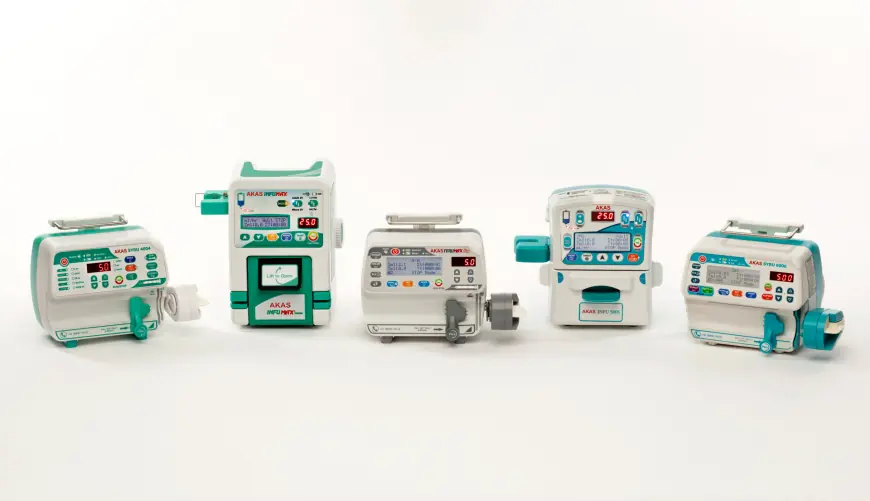Understanding the Maintenance and Calibration of Volumetric Infusion Pumps
Learn the importance of maintaining and calibrating Volumetric Infusion Pumps in healthcare settings to ensure precise and safe medication delivery.

Introduction to Volumetric Infusion Pumps
Volumetric Infusion Pumps are crucial in delivering intravenous fluids and medications to patients in a controlled, accurate manner. Hospitals rely on these pumps to ensure that patients receive the exact dosage and flow rate required for their treatment. However, ensuring the continued accuracy and safety of these pumps requires regular maintenance and calibration.
In this blog, we will explore the importance of properly maintaining and calibrating Volumetric Infusion Pumps, the best practices for doing so, and how hospitals and medical institutions can ensure the reliability of these vital devices.
The Importance of Maintenance and Calibration
- Ensuring Accurate Drug Delivery:
- Volumetric Infusion Pumps must be maintained to deliver precise doses of medication. Any malfunction could result in under or over-delivery, which can have serious consequences for the patient’s health. Calibration ensures the accuracy of dosage delivery.
- Improving Patient Safety:
- Routine maintenance helps to identify and fix any potential issues before they lead to malfunctions. Regular checks on pumps ensure that they are functioning optimally, minimizing the risk of errors in medication administration.
- Extending Equipment Lifespan:
- Proper care, including maintenance and calibration, can significantly extend the lifespan of infusion pumps. This reduces the need for frequent replacements, saving healthcare institutions costs in the long term.
Key Aspects of Volumetric Infusion Pump Maintenance
- Regular Cleaning:
- To maintain the functionality of a Volumetric Infusion Pump, regular cleaning is essential. Dust, debris, and fluids can accumulate over time, affecting the performance of the device. Proper cleaning ensures that all parts of the pump, including the tubing, are free from blockages or contamination.
- Inspecting for Wear and Tear:
- Frequent inspection of the pump’s components, including the power supply, tubing, and valves, is necessary to identify any signs of wear. Replacing worn-out parts promptly helps avoid more severe issues down the road.
- Software Updates:
- Infusion pumps are equipped with sophisticated software to manage medication delivery. Keeping this software updated ensures that the pump operates efficiently, with the latest features and safety protocols integrated.
- Battery Care:
- The battery is a critical component in the operation of Volumetric Infusion Pumps. It is important to regularly check the battery's charge capacity and replace it when necessary. A fully charged battery ensures that the pump continues to function, even in emergency situations.
- Proper Storage:
- When not in use, pumps should be stored in a clean, dry environment, away from direct sunlight and extreme temperatures. Storing pumps correctly reduces the risk of damage and prolongs their usability.
Calibration of Volumetric Infusion Pumps
- What is Calibration?
- Calibration refers to the process of adjusting the pump’s settings to ensure it accurately delivers the prescribed medication at the correct flow rate. Over time, even well-maintained pumps can drift from their original calibration, making regular checks essential.
- Calibration Process:
- The process involves testing the pump’s delivery against a known standard, typically using a calibrated syringe or other measurement device. If discrepancies are found, adjustments are made to restore the pump’s accuracy.
- Frequency of Calibration:
- Calibration should be performed at regular intervals, as specified by the manufacturer’s guidelines. It is typically done after every use, at scheduled maintenance intervals, or whenever the pump is repaired. Hospitals should maintain a record of calibration dates to ensure consistency and accountability.
- Self-Testing Features:
- Many modern Volumetric Infusion Pumps come with self-test features that automatically verify the accuracy of the pump’s delivery. However, these tests should still be supplemented with manual calibration to ensure thorough verification.
- Why Calibration Matters:
- Calibration ensures that the pump delivers medication within the acceptable margin of error. For high-risk medications, such as chemotherapy drugs, precise calibration is critical to patient safety.
Training for Hospital Staff
- Proper Training on Maintenance:
- Healthcare professionals must receive training on the correct maintenance procedures for Volumetric Infusion Pumps. Understanding how to inspect, clean, and maintain these pumps will reduce the likelihood of errors caused by poor handling.
- Understanding Calibration Procedures:
- Staff should be thoroughly trained in how to calibrate Volumetric Infusion Pumps. This includes learning how to conduct the manual calibration checks, interpret results, and make adjustments if necessary.
- Handling Emergency Situations:
- In emergency settings, infusion pumps may need to be calibrated or maintained quickly. Training staff to perform essential tasks in high-pressure situations ensures patient care isn’t compromised.
- Documentation and Record-Keeping:
- It is important to document all maintenance and calibration activities. Detailed records can help in troubleshooting issues and ensuring that pumps are always ready for use.
Troubleshooting Common Issues
- Pump Alarm Troubleshooting:
- Infusion pumps are equipped with alarm systems that notify healthcare providers if there is an issue with the pump, such as a blocked line or delivery irregularity. Regularly checking the alarm settings and ensuring they are functional is part of routine maintenance.
- Inconsistent Flow Rates:
- If the pump is delivering an inconsistent flow rate, it may be a sign of a mechanical failure or the need for recalibration. Troubleshooting involves inspecting the device, ensuring the correct settings are in place, and recalibrating the pump if necessary.
- Error Codes and Displays:
- Infusion pumps may display error codes when there is a malfunction. Understanding what these codes mean and how to address them is essential for efficient troubleshooting and quick resolution.
How Hospitals Can Ensure Optimal Performance
- Establish a Preventive Maintenance Schedule:
- Healthcare facilities should establish a preventive maintenance schedule based on the manufacturer’s guidelines. Routine checks will help keep all Volumetric Infusion Pumps in top condition, ensuring that they are always ready for use.
- Partnering with Reliable Service Providers:
- Partnering with trusted service providers for pump maintenance and calibration ensures that the pumps are serviced by experts familiar with the latest technologies and safety standards.
- Investing in Quality Infusion Pumps:
- Choosing high-quality Volumetric Infusion Pumps from reliable manufacturers is the first step in ensuring long-term performance. Investing in reputable brands reduces the likelihood of malfunction and ensures that the equipment meets the necessary safety standards.
Conclusion
The proper maintenance and calibration of Volumetric Infusion Pumps are essential to the safe and effective delivery of medications in healthcare settings. By adhering to regular maintenance schedules, investing in proper training, and partnering with trusted service providers, hospitals can ensure the reliability of their infusion pumps.
Akas Infusion manufactures world-class drug delivery devices, including Volumetric Infusion Pumps, designed to provide accurate and safe medication administration. Partnering with reputable manufacturers like Akasinfusion ensures that hospitals and medical institutions can meet the highest standards of patient care.
What's Your Reaction?
 Like
0
Like
0
 Dislike
0
Dislike
0
 Love
0
Love
0
 Funny
0
Funny
0
 Angry
0
Angry
0
 Sad
0
Sad
0
 Wow
0
Wow
0






















































